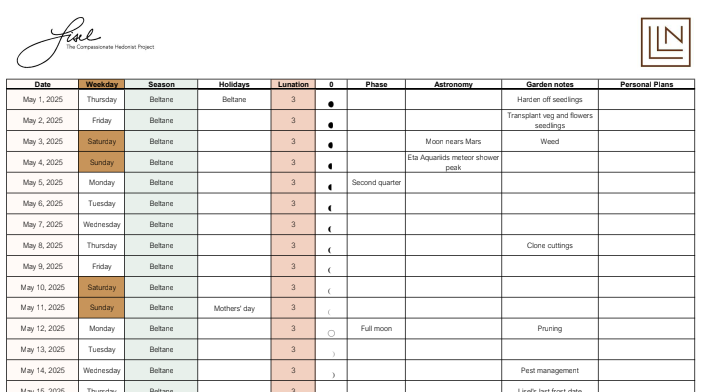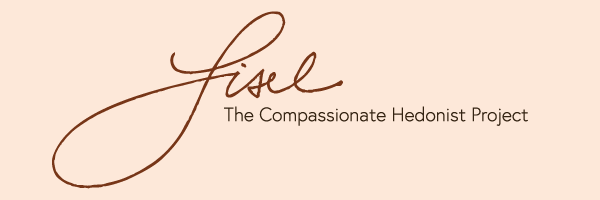Introduction to Almanancy
It's basically just calendars, man...
I like to align myself with nature’s calendar to rise above the structure imposed; to make the oligarchy’s calendar subservient to nature’s.
This helps me redefine my life pace, bring balance, connect with time and place, be present, bring rhythm, and establish a home base for the work of the mundane, sacred, and extraordinary. To survive the suffering of the day and find joy in the comfort.
Reorientation
Our calendars and clocks are related to the rhythm of nature, but not fully aligned. We have to add an extra day every four years for the solar year to line up.
While we have twelve months in the calendar, there are 12.36 moon cycles in a solar year.
We completely ignore the time it takes the earth to make a full revolution in a day (a sidereal day), and instead track the solar day by returning to face the sun directly.
Satellites in orbit experience time dilation must adjust their clocks to stay in sync with earth due to the difference in gravitation pull.
It is easy to understand the need for a common language of time for a functioning society. However, I chose to discard it whenever possible.
Solar Cycle
Thanks to the tilt of our axis, we have a convenient way to mark the movement of time here on earth. The start of the solar year seems to be most commonly accepted as the spring equinox. Personally, I’ve enjoyed using the celebrating new year at the start of Samhain, November 1 or 2 of each year, inspired by other pagan traditions. The idea of starting the solar cycle with the final harvest feels so bountiful to me. The new year starts with preparing to rest during the winter. Picture snacking on bountiful cut fruits while you and a friend cook up some jams and jellies!
Each year running up to Samhain, I reflect on the cycle coming to a close and brainstorm themes, symbols, totems, sigils for the coming year. For this year (November 1, 2025 – October 31, 2026), I chose a theme of Slow Growth inspired by reading The Hidden Life of Trees by Peter Wohlleben. Trees are always thinking and planning ahead. Beech trees start storing up for a mast product of beech nuts the year before and only mast every three of four years. Unbeknownst to me, my European Beech had a hollow heart and the weight of that final crop and 45 mph wind gusts took down the behemoth in 2023. Her shredded remains are feeding my garden beds. As the trees begin to bud, a shoot from the stump is putting out leaves in defiance of death.
But back to the solar year…
I enjoy eight high holy days:
Samhain ~November 1
Winter Solstice (Yule) ~ December 21
Imbolc ~ February 1
Spring Equinox (Ostara) ~ March 21
Beltane ~ May 1
Summer Solstice (Litha) ~ June 21
Lughnasadh ~ August 1
Autumn Equinox (Mabon) ~ September 2`
I draw from traditional pagan practices and am learning about the traditions of the Anishinaabe people whose land I pretend to own. I draw from farming and plant growth cycles. I draw from concepts of yin and yang. I find the solar cycle to be a scaffold for big ideas and personal growth, with seasons of preparation, rest, planning, vegetation, blossoming, fruiting, dying back and even rotting. Cleaning out the excessive dead matter, but leaving rich compost behind to feed the roots of the next growing season.
Lunar Cycle
Who doesn’t love the moon? When the full moon is at its zenith, I sometimes look up and think about all the other humans that are looking at the same thing as me right that moment. For me, the moon gets as high as 74 degrees declination in the sky during the winter, and as low as 16 degrees declination in the summer. Someone in New Zealand at 45 degrees south would see the same variation, but the moon will be upside down. If that makes your brain hurt like it does mine, I suggest building a diorama and whipping out a flashlight. We may have different perspectives depending on our location in place, but it’s the same moon at the same time and that is deeply grounding for my sense of reality.
There are about 12.5 lunar cycles per solar cycle. This mismatch is ignored in our Gregorian Calendar. This mismatch also causes a cycle of about 33.5 years before the moon is in the same position in the celestial sphere. Side note, Islam uses the lunar cycle for their religious calendar, which processes (moves backward in our standard calendar) Ramadan by about 12 days per year. This Roman farming calendar recognized lunar cycles in the farming season, with the new moon indicated in each month of this fascinating artefact.
In Red Mars, Kim Stanley Robinson explains how Mars colonists align Mars’ longer solar day to Earth’s 24 hours:
And then it was ringing midnight, and they were in the Martian time slip, the thirty-nine-and-a-half-minute gap between 12:00:00 and 12:00:01, when all the clocks went blank or stopped moving. This was how the first hundred had decided to reconcile Mars’s slightly longer day with the twenty-four-hour clock, and the solution had proved oddly satisfactory. Every night to step for a while out of the flicking numbers, out of the remorseless sweep of the second hand…
The concept of a time slip has tickled something in my brain ever since. Like the Martian day, I can reconcile the asynchronicity of the lunar cycles to the solar cycle by ignoring the lunations during the dead of winter, like a Roman farmer. This alignment with the 34 year lunar cycle is pleasing, and the two lunations of down time is restful, a relaxing time slip.
Gardening with the Moon
If you’ve been exposed to gardening with the moon, then you’ll understand why this was the next natural topic I tripped across in my lunar calendar research. For a full explanation, check out this summary. I’ll summarize it here:
First quarter (new moon to waxing quarter): Plants where you eat the stems and leaves, annuals.
Second quarter (waxing quarter to full moon): Plants where you eat the flowers or fruits.
Third quarter (full moon to waning quarter): Root veggies, perennials, biennials.
Fourth quarter (waning quarter – new moon); TIME SLIP (some garden cleanup is OK).
Again, I love it. Scheduled, guilt-free, naturally aligned, and delicious rest. Time off.
In my personal life, I use the lunar cycle to enhance shorter term planning and personal development. I used to do a little ritual, such as journaling or meditation, on the new and full moon. Now I use that energy more literally in my garden for most cycles. But if there’s something really sticking in my craw, some goal I am focused on accomplishing, I don’t mind using whatever magic is out there to build an intention on the new moon, and watch it come to fruition on the full moon. And then rest. Let the ritual do its work.
Lisel’s Alamanc
So how does this all come together? It’s complicated. And I haven’t even mentioned the 26,000 year zodiacal precession cycle of the earth’s axis, or the 225 million year cycle of the solar system above and below the galactic plane. Let’s not get quite that big.
This newsletter’s freebie is my current year calendar with the high holy days of the solar cycle and the rhythm of the lunar cycle. I’ve left some space for your own notes and schedule, and added a few other sketches of ideas for your bemusement. I’ll be using this as the basis for the seasonal almanac updates. Missed my last post? Download the Beltane almanac volume here!
Wishing my readers an aromatic spring!
Until next time,






Thank you for reading!